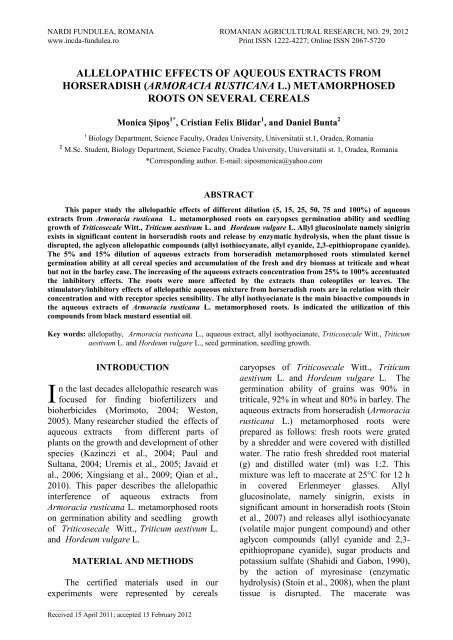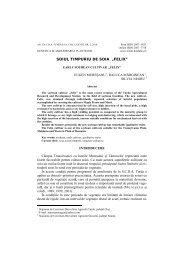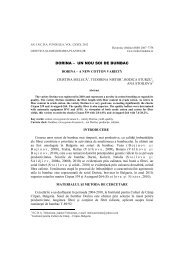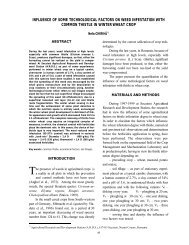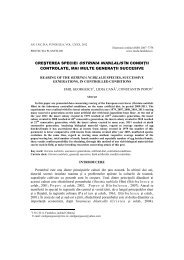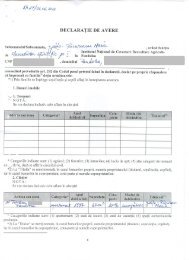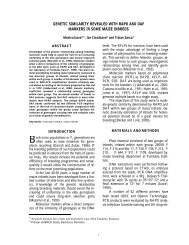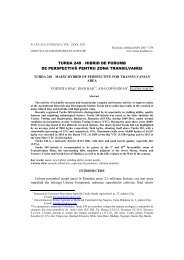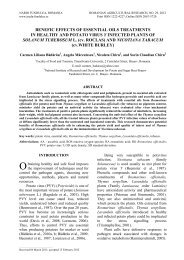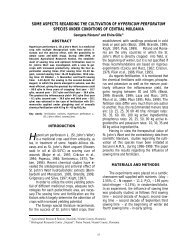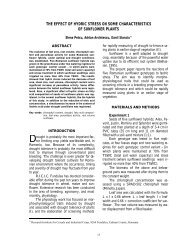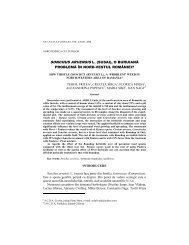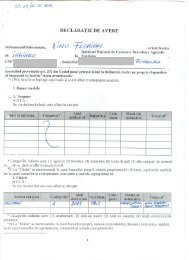Allelopathic effects of aqueous extracts from
Allelopathic effects of aqueous extracts from
Allelopathic effects of aqueous extracts from
You also want an ePaper? Increase the reach of your titles
YUMPU automatically turns print PDFs into web optimized ePapers that Google loves.
NARDI FUNDULEA, ROMANIA ROMANIAN AGRICULTURAL RESEARCH, NO. 29, 2012<br />
www.incda-fundulea.ro Print ISSN 1222-4227; Online ISSN 2067-5720<br />
ALLELOPATHIC EFFECTS OF AQUEOUS EXTRACTS FROM<br />
HORSERADISH (ARMORACIA RUSTICANA L.) METAMORPHOSED<br />
ROOTS ON SEVERAL CEREALS<br />
Monica Şipoş 1* , Cristian Felix Blidar 1 , and Daniel Bunta 2<br />
1 Biology Department, Science Faculty, Oradea University, Universitatii st.1, Oradea, Romania<br />
2<br />
M.Sc. Student, Biology Department, Science Faculty, Oradea University, Universitatii st. 1, Oradea, Romania<br />
*Corresponding author. E-mail: siposmonica@yahoo.com<br />
ABSTRACT<br />
This paper study the allelopathic <strong>effects</strong> <strong>of</strong> different dilution (5, 15, 25, 50, 75 and 100%) <strong>of</strong> <strong>aqueous</strong><br />
<strong>extracts</strong> <strong>from</strong> Armoracia rusticana L. metamorphosed roots on caryopses germination ability and seedling<br />
growth <strong>of</strong> Triticosecale Witt., Triticum aestivum L. and Hordeum vulgare L. Allyl glucosinolate namely sinigrin<br />
exists in significant content in horseradish roots and release by enzymatic hydrolysis, when the plant tissue is<br />
disrupted, the aglycon allelopathic compounds (allyl isothiocyanate, allyl cyanide, 2,3-epithiopropane cyanide).<br />
The 5% and 15% dilution <strong>of</strong> <strong>aqueous</strong> <strong>extracts</strong> <strong>from</strong> horseradish metamorphosed roots stimulated kernel<br />
germination ability at all cereal species and accumulation <strong>of</strong> the fresh and dry biomass at triticale and wheat<br />
but not in the barley case. The increasing <strong>of</strong> the <strong>aqueous</strong> <strong>extracts</strong> concentration <strong>from</strong> 25% to 100% accentuated<br />
the inhibitory <strong>effects</strong>. The roots were more affected by the <strong>extracts</strong> than coleoptiles or leaves. The<br />
stimulatory/inhibitory <strong>effects</strong> <strong>of</strong> allelopathic <strong>aqueous</strong> mixture <strong>from</strong> horseradish roots are in relation with their<br />
concentration and with receptor species sensibility. The allyl isothyocianate is the main bioactive compounds in<br />
the <strong>aqueous</strong> <strong>extracts</strong> <strong>of</strong> Armoracia rusticana L. metamorphosed roots. Is indicated the utilization <strong>of</strong> this<br />
compounds <strong>from</strong> black mustard essential oil.<br />
Key words: allelopathy, Armoracia rusticana L., <strong>aqueous</strong> extract, allyl isothyocianate, Triticosecale Witt., Triticum<br />
aestivum L. and Hordeum vulgare L., seed germination, seedling growth.<br />
I<br />
INTRODUCTION<br />
n the last decades allelopathic research was<br />
focused for finding bi<strong>of</strong>ertilizers and<br />
bioherbicides (Morimoto, 2004; Weston,<br />
2005). Many researcher studied the <strong>effects</strong> <strong>of</strong><br />
<strong>aqueous</strong> <strong>extracts</strong> <strong>from</strong> different parts <strong>of</strong><br />
plants on the growth and development <strong>of</strong> other<br />
species (Kazinczi et al., 2004; Paul and<br />
Sultana, 2004; Uremis et al., 2005; Javaid et<br />
al., 2006; Xingsiang et al., 2009; Qian et al.,<br />
2010). This paper describes the allelopathic<br />
interference <strong>of</strong> <strong>aqueous</strong> <strong>extracts</strong> <strong>from</strong><br />
Armoracia rusticana L. metamorphosed roots<br />
on germination ability and seedling growth<br />
<strong>of</strong> Triticosecale Witt., Triticum aestivum L.<br />
and Hordeum vulgare L.<br />
MATERIAL AND METHODS<br />
The certified materials used in our<br />
experiments were represented by cereals<br />
caryopses <strong>of</strong> Triticosecale Witt., Triticum<br />
aestivum L. and Hordeum vulgare L. The<br />
germination ability <strong>of</strong> grains was 90% in<br />
triticale, 92% in wheat and 80% in barley. The<br />
<strong>aqueous</strong> <strong>extracts</strong> <strong>from</strong> horseradish (Armoracia<br />
rusticana L.) metamorphosed roots were<br />
prepared as follows: fresh roots were grated<br />
by a shredder and were covered with distilled<br />
water. The ratio fresh shredded root material<br />
(g) and distilled water (ml) was 1:2. This<br />
mixture was left to macerate at 25°C for 12 h<br />
in covered Erlenmeyer glasses. Allyl<br />
glucosinolate, namely sinigrin, exists in<br />
significant amount in horseradish roots (Stoin<br />
et al., 2007) and releases allyl isothiocyanate<br />
(volatile major pungent compound) and other<br />
aglycon compounds (allyl cyanide and 2,3-<br />
epithiopropane cyanide), sugar products and<br />
potassium sulfate (Shahidi and Gabon, 1990),<br />
by the action <strong>of</strong> myrosinase (enzymatic<br />
hydrolysis) (Stoin et al., 2008), when the plant<br />
tissue is disrupted. The macerate was<br />
___________________________________________<br />
Received 15 April 2011; accepted 15 February 2012
170 Number 29/2012<br />
ROMANIAN AGRICULTURAL RESEARCH<br />
squeezed and <strong>aqueous</strong> etract was filtered<br />
through filter paper. This extract was<br />
considered 100% and was preserved for short<br />
time (3 days) in dark glass at 4°C.<br />
Allyl isotiocianate is unstable and<br />
gradually decomposes in approximately ten<br />
days, in aqueos solution at room temperature,<br />
to paraffin like hydrocarbon and sulfur.<br />
Moreover, N, N’-diallylthiourea is produced<br />
by action <strong>of</strong> water (Kawakishi and Namiki,<br />
1969). The <strong>aqueous</strong> extract considered 100%<br />
was diluted with distilled water to 5%, 15%,<br />
25%, 50% and 75% (Corbu et al., 2007).<br />
The germination <strong>of</strong> caryopses was<br />
performed in sterile colourless plastic<br />
casseroles. Sterilization <strong>of</strong> the casseroles was<br />
made by submersing them in sodium hypochlorite<br />
solution 1% for 12 h and washed with<br />
tap water in abundance. Pre-disinfection treatment<br />
<strong>of</strong> grains was made with ethylic<br />
alcohol 96° for 30 seconds and after this procedure<br />
grains were disinfected by submersing<br />
them in sodium hypochlorite solution 2% for<br />
1 minute and then washing with sterile water<br />
(Sauer and Burroughs, 1986). The bottom <strong>of</strong><br />
casseroles was covered with filter paper which<br />
was moistened with 25 ml <strong>of</strong> different dilution<br />
<strong>of</strong> the <strong>aqueous</strong> <strong>extracts</strong> (5, 15, 25, 50, 75 and<br />
100%) and with the same volume <strong>of</strong> distilled<br />
water for controls. For all experimental<br />
variants and control, lots 50 caryopses were<br />
placed in each casserole. The germination ability<br />
was detemined in six replicates. The covered<br />
coourless casseroles were then placed in a<br />
germination cabinet at 25-27°C in the dark.<br />
Germination ability was determined after 3<br />
days and in the casseroles with plantlets for<br />
biometry - two replicates- 20 ml <strong>of</strong> the differrent<br />
dilutions <strong>from</strong> <strong>aqueous</strong> extract or distilled<br />
water (for control) were added. For seedling<br />
growth, after 5 day <strong>of</strong> germination, the<br />
embryonic and adventitious root length,<br />
coleoptiles and first leaf length (mm), fresh<br />
and dry biomass <strong>of</strong> the plantlets (mg) was<br />
determined. For dry biomass plantlets were<br />
dehydrated at 80°C for 24 hours. Statistical<br />
analysis included: arithmetic mean (M),<br />
standard deviation (s d ) and Student’s test <strong>of</strong><br />
significance (SigmaPlot 2001 s<strong>of</strong>tware). The<br />
significance level was set at P
171<br />
MONICA ŞIPOŞ ET AL.: ALLELOPATHIC EFFECTS OF AQUEOUS EXTRACTS FROM HORSERADISH<br />
(ARMORACIA RUSTICANA L.) METAMORPHOSED ROOTS ON SEVERAL CEREALS<br />
Table 1. Values <strong>of</strong> the response index (RI) and significance level<br />
(a = insignificant P>0.05; b = significant P
172 Number 29/2012<br />
ROMANIAN AGRICULTURAL RESEARCH<br />
The allyl isothyocianate is the main bioactive<br />
compounds in the <strong>aqueous</strong> <strong>extracts</strong> <strong>of</strong><br />
Armoracia rusticana L. metamorphosed roots.<br />
The main chemical component <strong>of</strong> black mustard<br />
oil has no less than 92% allyl isothiocyanate<br />
(http://www.essentialoils.co.za/essentialoils/mustard.htm#Chemical).<br />
The actual use <strong>of</strong> <strong>aqueous</strong> <strong>extracts</strong> <strong>from</strong><br />
metamorphosed horseradish roots would be<br />
less recommended because several variables<br />
may occur during their preparation: the<br />
amount <strong>of</strong> sinigrin in the roots varies<br />
depending on the ontogenetic stage <strong>of</strong> the<br />
plant (Corbu et al., 2007); the shredding<br />
degree <strong>of</strong> the material influences the release <strong>of</strong><br />
myrosinase and this enzyme decomposes the<br />
sinigrin depending on the temperature<br />
conditions it is subjected to (Sahidi and<br />
Gabon, 1990; Stoin et al., 2008); the <strong>aqueous</strong><br />
solutions must be freshly prepared as the allyl<br />
isothiocyanate decomposes (Kawakishi and<br />
Namiki, 1969). The limit between the<br />
stimulating and inhibitory concentrations must<br />
be established with high accuracy for each<br />
species. Any mistake in concentration may<br />
lead to bioinhibition instead <strong>of</strong> biostimulation<br />
and vice versa. If stimulating concentrations<br />
for grain crops are inhibitory for certain<br />
weeds, <strong>aqueous</strong> solutions with allyl<br />
isothiocyanate might be used as bioherbicide.<br />
Recent researches aim at using essential oils<br />
extracted <strong>from</strong> plants for their bioactive<br />
compounds (Cavalieri and Caporali, 2010;<br />
Mutlu et al., 2010, Jinbao et al., 2010).<br />
CONCLUSIONS<br />
The germinating ability <strong>of</strong> triticale, wheat<br />
and barley seed was stimulated by the 5% and<br />
15% dilutions <strong>of</strong> the <strong>aqueous</strong> extract <strong>of</strong> the<br />
metamorphosed horseradish roots. The<br />
increase in the concentration <strong>of</strong> the <strong>aqueous</strong><br />
<strong>extracts</strong> (50%, 75%, and 100%) caused<br />
significant and progressive inhibition <strong>of</strong><br />
germinating ability in all three species.<br />
The seedling roots <strong>of</strong> the three species<br />
studied by us proved to be sensitive to the<br />
action <strong>of</strong> the bioactive compounds, even at<br />
5% and 15% dilutions <strong>of</strong> <strong>aqueous</strong> <strong>extracts</strong> <strong>of</strong><br />
horseradish; significant inhibitions <strong>of</strong> their<br />
growth in length was noticed.<br />
The coleoptiles and first leaves <strong>of</strong><br />
triticale, wheat and barley seedlings were less<br />
sensitive to the action <strong>of</strong> allyl isothiocyanate<br />
than the roots, and stimulation <strong>of</strong> their growth<br />
occurs under the action <strong>of</strong> 5%, 15% and even<br />
25% dilutions <strong>of</strong> <strong>aqueous</strong> <strong>extracts</strong> <strong>of</strong><br />
metamorphosed horseradish. The <strong>aqueous</strong><br />
<strong>extracts</strong> <strong>of</strong> higher concentrations (50%, 75%,<br />
100%) caused statistically significant<br />
inhibitions <strong>of</strong> the growth in length <strong>of</strong> the<br />
coleoptiles in triticale, wheat and barley.<br />
The experimental results regarding the<br />
fresh and dry biomass <strong>of</strong> the seedlings<br />
revealed stimulations <strong>of</strong> these parameters only<br />
in triticale and wheat and at 5% and 15%<br />
dilutions.<br />
Higher concentrations produced only<br />
inhibitions <strong>of</strong> these two parameters,<br />
inhibitions that advanced <strong>from</strong> insignificant to<br />
significant as the concentration <strong>of</strong> bioactive<br />
substances in the <strong>aqueous</strong> <strong>extracts</strong> increased.<br />
One must accurately establish the limit<br />
between the stimulatory and inhibitory<br />
concentrations for each species. In certain<br />
concentrations, the allyl isothiocyanate can be<br />
used as natural biostimulator or herbicide, if<br />
some weeds will prove to be more susceptible<br />
to its action than crop plants.<br />
REFERENCES<br />
Cavalieri, A., Caporali, F., 2010. Effects <strong>of</strong> essential<br />
oils <strong>of</strong> cinnamon, lavander and peppermint on<br />
germination <strong>of</strong> mediterranean weeds, Allelopathy<br />
Journal, 25 (2), http://www.allelopathyjournal.com/allelopathy.aspx?target=ijor:aj&volum<br />
e = 25&issue =2&article=003<br />
Corbu, S., Cachiţă, C.D., Şipoş, M., 2007. Efectul<br />
alelopatic al extractului apos de hrean (Armoracia<br />
rusticana L.) asupra germinaţiei şi creşterii<br />
plantulelor de mazăre (Pisum sativum L.) şi de<br />
castraveţi (Cucumis sativus L.), Studia<br />
Universitatis Vasile Goldiş, Seria ŞtiinţeleVieţii,<br />
17: 51-54<br />
Javaid, A., Shafique, S., Bajwa, R., Shafique, S., 2006.<br />
Effect <strong>of</strong> <strong>aqueous</strong> <strong>extracts</strong> <strong>of</strong> allelopathic crops on<br />
germination and growth <strong>of</strong> Parthenium<br />
hysterophorus L., South African Journal <strong>of</strong> Botany,<br />
72 (4): 609-612.<br />
Jinbao, Z., Min, A., Hanwen, W., Rex, S., Deirdre, L.,<br />
2010. Chemistry and bioactivity <strong>of</strong> Eucalyptus<br />
essential oils, Allelopathy Journal, 25(2),<br />
http://www.allelopathyjournal.com/allelopathy.aspx?target=ijor:aj&volum<br />
e= 25&issue=2&article=016
173<br />
MONICA ŞIPOŞ ET AL.: ALLELOPATHIC EFFECTS OF AQUEOUS EXTRACTS FROM HORSERADISH<br />
(ARMORACIA RUSTICANA L.) METAMORPHOSED ROOTS ON SEVERAL CEREALS<br />
Kawakishi, S., Namiki, M., 1969. Decomposition <strong>of</strong> allyl<br />
isothiocyanate in <strong>aqueous</strong> solution, Agricultural and<br />
Biological Chemistry, 33: 452-459.<br />
Kazinczi, G., Beres, I., Mikulas, J., Nadasy, E., 2004.<br />
Allelophatic effect <strong>of</strong> Cirsium arvense and<br />
Asclepias syriaca, Journal <strong>of</strong> Plant Diseases and<br />
Protection, 19: 301-308.<br />
Morimoto, M., 2004. Allelochemicals in plant and their<br />
applications for the lead <strong>of</strong> agrochemicals, Regulation<br />
<strong>of</strong> Plant Growth and Development 39: 214-224.<br />
Mutlu, S., Atici, Ö., Esim, N., 2010. Bioherbicidal<br />
<strong>effects</strong> <strong>of</strong> essential oils <strong>of</strong> Nepeta meyeri Benth. on<br />
weed spp., Allelopathy Journal, 26 (2)<br />
http://www.allelopathyjournal.com/allelopathy.aspx?target=ijor:aj&volum<br />
e= 26&issue=2&article=013<br />
Obaid, A., Qasem, J.R., 2005. <strong>Allelopathic</strong> activity <strong>of</strong><br />
common weed species on vegetable crops in<br />
Jordan, Allelopathy Journal, 15 (2)<br />
http://www.allelopathyjournal.com/allelopathy.aspx?target=ijor:aj&volum<br />
e =15&issue= 2&article=004<br />
Paul, N.K., Sultana, M. Q., 2004. <strong>Allelopathic</strong> <strong>effects</strong> <strong>of</strong><br />
Eichhornia crassipes on seed germination and<br />
seedling growth <strong>of</strong> wheat, rice, lentil and chickpea,<br />
Bangladesh Journal <strong>of</strong> Botany, 33: 121-123<br />
Qian, L., Jing, C., Zaimin, J., Shuoxin, Z., 2010.<br />
Allelophatic <strong>effects</strong> <strong>of</strong> walnut leaves leachate on<br />
seed germination, seedling growth <strong>of</strong> medicinal<br />
plants, Allelopathy Journal 26 (2),<br />
http://www.allelopathyjournal.com/allelopathy.aspx?target=ijor:aj&volum<br />
e= 26&issue =2&article=008<br />
Sauer, D.B., Burroughs, R., 1986. Disinfection <strong>of</strong> seed<br />
surfaces with sodium hypoclorite, Phitopathology,<br />
76: 745-749.<br />
Shahidi, F., Gabon, J.E., 1990. Fate <strong>of</strong> sinigrin in<br />
methanol/amonia/water-hexane extraction <strong>of</strong><br />
Brassica juncea mustard seed. Journal <strong>of</strong> Food<br />
Science, 55(3): 793-795.<br />
Stoin, D., Radu, F., Dogaru, D., 2007. Researches<br />
regarding the isolation, purification and analysis<br />
<strong>of</strong> sinigrin glucosinolate <strong>from</strong> Brassica nigra and<br />
Armoracia rusticana, Bulletin USAMV-CN, 63:<br />
77-82.<br />
Stoin, D., Radu, F., Poiană, M., Butnariu, M., Dogaru,<br />
D., 2008. The correlation <strong>of</strong> the myrosinase<br />
enzymatic activity <strong>from</strong> Armoracia rusticana<br />
determines by RP-HPLC tehnique and by UV-VIS<br />
spectrophometry, Bulletin UASVM, Agriculture,<br />
65 (1): 289-294.<br />
Uremis, I., Arslan, M., Uludag, A., 2005. <strong>Allelopathic</strong><br />
<strong>effects</strong> <strong>of</strong> some Brassica species on germination<br />
ang growth <strong>of</strong> cutleaf ground-cherry (Physalis<br />
angulata L.), Journal <strong>of</strong> Biological Sciences, 5:<br />
661-665.<br />
Weston, L.A., 2005. History and current trends in the<br />
use <strong>of</strong> allelopathy for weed management,<br />
HortTechnology 15: 529-535.<br />
Williamson, G.B., Richardson, D., 1988. Bioassays for<br />
allelopathy: measuring treatment response with<br />
independent controls, Journal <strong>of</strong> Chemicals<br />
Ecology, 14: 181-188.<br />
Xingxiang, G., Mei, L., Zongjun, G., Hongjun, Z.,<br />
Zuowen, S., 2009. <strong>Allelopathic</strong> <strong>effects</strong> <strong>of</strong> Conyza<br />
canadensis in the germination and growth <strong>of</strong><br />
wheat, sorghum, cucumber, rape and radish,<br />
Allelopathy Journal, 23 (2),<br />
http://www.allelopathy-Journal.com/allelopathy.aspx<br />
?target=ijor:aj&volume=23&issue =2&article=005<br />
http://www.essentialoils.co.za/essentialoils/mustard.htm#Chemical


